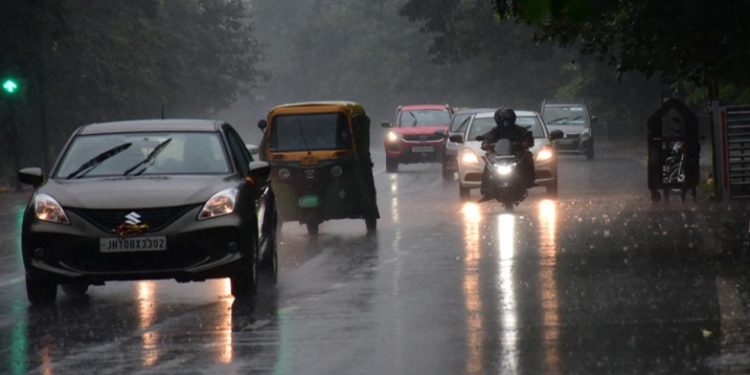New Delhi: Fresh downpour in parts of India Sunday compounded the woes of some flood-ravaged states, where swollen rivers inundated new areas, roads were blocked and educational institutions were closed.
Punjab, which has been hit by flash floods, received fresh rain. In Uttarakhand, a rain-triggered landslide blocked tunnels of a power project in Pithoragarh, trapping 11 people.
In Himachal Pradesh, which has been hit by landslides, cloudbursts and flash floods this monsoon, rescuers braced for more arduous work as the meteorological department issued a ‘red’ alert for very heavy to extremely heavy rains over the next three days and warned of landslides, flash floods and land subsidence.
A cloudburst near Chennai, Tamil Nadu, brought heavy rain to the city and led to the diversion of flights.
Respite from the inclement weather is unlikely soon, with the India Meteorological Department (IMD) saying that the country is likely to receive above-normal rainfall in September.
Rain lashed several parts of Punjab and more is likely in the coming days, according to the meteorological department.
In Kapurthala, one of the worst-hit districts, the administration issued an alert asking people in the Sultanpur Lodhi area to move to safer places as the water level of the Beas river rose further due to the rain.
The Patiala district administration asked people not to go near the banks of the Ghaggar and Tangri rivers as their water levels rose due to rains in their catchment areas.
The meteorological department said light to moderate rain is likely at most places in Punjab from August 31 to September 1 and at many places September 2. Heavy rain is likely at isolated places September 2.
Chief Minister Bhagwant Mann wrote to Prime Minister Narendra Modi and urged him to release Rs 60,000 crore of the “state’s funds”, which he claimed are “stuck” with the Centre.
In the letter to PM Modi, Mann stated Punjab was currently grappling with one of the worst flood disasters in decades, impacting about 1,000 villages and lakhs of people.
The state government Sunday extended the closure of schools till September 3 due to the floods.
According to officials, Punjab received 253.7 mm of rain in August, 74 per cent in excess of normal and the state’s highest in 25 years.
In Uttarakhand’s Pithoragarh, 11 National Hydroelectric Power Corporation Limited (NHPC) employees were trapped inside a power house as a landslide triggered by heavy rain blocked normal and emergency tunnels of Dhauliganga Power Project, officials said.
Initially, 19 people were trapped but eight of them were rescued by the administration, they said.
JCB machines of the Border Roads Organisation and a haulage company have been deployed to clear the debris, an official said.
The meteorological centre in Shimla issued a ‘red’ alert for very heavy to extremely heavy rains in four to six districts of Himachal Pradesh from Sunday to Tuesday. It warned of landslides, flash floods, land subsidence, waterlogging and swelling of water bodies.
Himachal Pradesh received 72 per cent excess rain in August. It received 440.8 mm of rainfall against the season’s average of 256.8 mm, according to official data.
Chief Minister Sukhvinder Singh Sukhu reviewed the situation in the state and the damage caused by incessant rainfall. He directed the chief secretary to accelerate rescue and relief operations.
Landslides and flash floods have wreaked havoc in many parts of the state, leading to the closure of 666 roads, including three national highways, Sunday morning, officials said.
From June 20, the onset of monsoon in the state, to August 30, Himachal Pradesh has witnessed 91 flash floods, 45 cloudbursts and 95 major landslides, the State Emergency Operation Centre said.
The state has suffered losses to the tune of Rs 3,056 crore this monsoon, and 320 people have died in rain-related incidents and road accidents, it said.
Tamil Nadu’s state capital Chennai received heavy overnight rain and its northern neighbouring city of Manali was hit by a cloudburst, the regional meteorological centre said.
Some flights scheduled to arrive at the Chennai airport were diverted to Bengaluru, according to airport authorities.
India received 743.1 mm of rainfall between June 1 and August 31, about 6 per cent above the long-period average of 700.7 mm, IMD data showed.
June rainfall was 180 mm, around 9 per cent above normal, with large surpluses in northwest and central India. July brought 294.1 mm of rainfall, around 5 per cent above normal, led by a 22 per cent surplus in central India. August added 268.1 mm, 5.2 per cent above normal.
The monthly average rainfall in September is expected to be more than 109 per cent of the long-period average of 167.9 mm, the IMD said.
Heavy rainfall in September may trigger landslides and flash floods in Uttarakhand and could disrupt normal life in south Haryana, Delhi and north Rajasthan, it said.
PTI







































